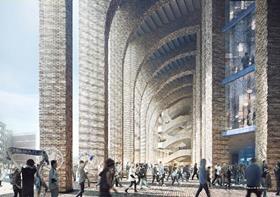Council planners recommended to approve 60,000 seat landmark at meeeting next week
Premier League pacesetters Chelsea are set to get the go-ahead for Herzog & de Meuron-designed plans to redevelop their Stamford Bridge home, just-published council papers reveal.
The club submitted proposals to create a new 60,000-seat stadium – upping Stamford Bridge’s current capacity by almost 50% – to Hammersmith & Fulham council in November 2015.
After a year of scrutiny, which has seen concerns over the scheme’s impact on issues ranging from the local bat population to traffic levels, members of the council’s planning committee are now being recommended to give the authority’s planning chief delegated powers to approve the project when they meet next week.
Herzog & de Meuron’s proposal will replace Stamford Bridge’s collection of disconnected stands with a single, unified brick-clad stadium, expanding the constrained site by decking over an adjacent railway line.
The practice, which was responsible for the 2008 Beijing Olympics’ “Bird’s Nest” stadium, said its Chelsea design had been inspired by the gothic architecture of Westminster Abbey, which once owned the Stamford Bridge site and the brickwork of Fulham’s terraced streets.
Arcadis is cost manager, WSP and Schlaich Bergermann are providing engineering services, while WSP is also providing transport consultancy, and Aecom is strategic planner. The scheme’s “gothic skin” facade is being engineered by Eckersley O’Callaghan.
In a report to Hammersmith & Fulham’s January 11 planning applications committee meeting, case officer John Sanchez advises members that Herzog & de Meuron’s design has “has met the demands of a potentially difficult brief” and “builds upon the historic context of previous stadia on the site”.
He continues: “The resulting design is a high quality piece of design and a unique architectural solution. It would have the landmark qualities of a significant sporting venue with a clear identity and would declutter and unify the site.”
Sanchez concludes that there will be “no significant adverse effects as a result of the proposed development on any of the identified heritage assets, with the exception of the Billings and Brompton Conservation Area”.
The report said government heritage adviser Historic England had observed that the new stadium would complement the setting of the nearby Grade I listed Brompton Cemetery “to a greater degree than the present stadium, due to its uniformity and on the understanding that the new stadium is no higher than the existing [structure]”.
Almost 800 local residents gave consultation responses, split across Hammersmith and Fulham and neighbouring Kensington and Chelsea. More than 70% supported the proposals.
If councillors follow the recommendations in the officers’ report, delegated powers to approve the development will be subject to the support of London Mayor Sadiq Khan, and a long list of conditions.
Chelsea has previously targeted a 2021 completion date for the stadium.





























No comments yet